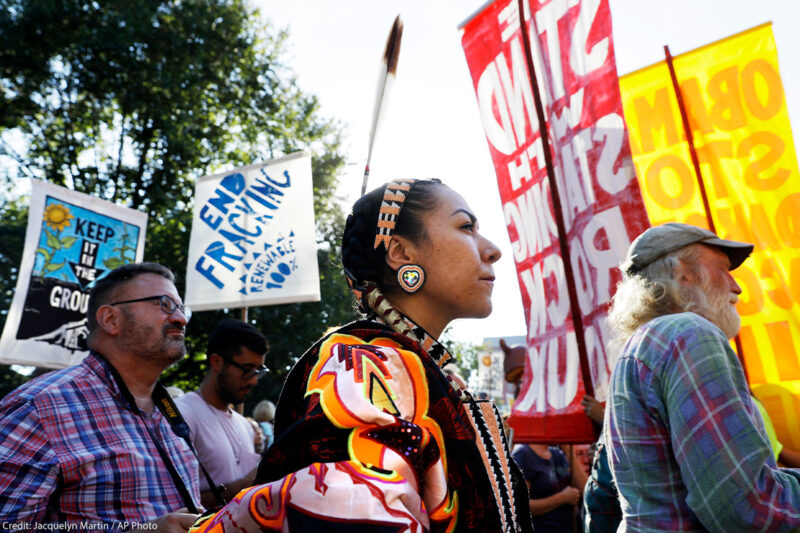The Streets Belong to the People — Always Have, Always Will


“Take to the streets.” These words have always held a special significance when it comes to exercising our right to protest. Throughout our history, generation after generation of activists, people, and communities have taken to our nation’s public streets to make their voices heard and to protest for their rights.
But, too often, the government still tries to shut down public protests and silence our voices through violence and oppression.
Indigenous-led protests have been frequent and special targets of these suppression tactics. In 2016 and 2017, those protesting the construction of the Dakota Access Pipeline near the Standing Rock Sioux Reservation were met with violence and surveillance, intentional barriers to media coverage, and militarized counterterrorism tactics developed for war zones. Communities protesting construction of the Keystone XL pipeline similarly contended with government efforts to silence them, including the creation of new anti-protest laws that targeted their cause specifically.
Recently, Indigenous protesters have had to deal with yet another government attempt to silence their voices. The government is trying to get rid of a lawsuit brought by four Standing Rock protesters and water protectors by relying on a troubling — and incorrect — argument: that some public streets, including rural streets, don’t belong to the community.
As we argued in a friend-of-the-court brief filed earlier this week, the government’s argument ignores the history of protest in our country, and it misunderstands our First Amendment rights. Our right to protest in the street is essential, and it shouldn’t depend on the location or other characteristics of the specific road we choose.
This isn’t the first time that the government has tried to argue that streets do not belong to the people. Over the summer, police officers repeatedly arrested and silenced people protesting police brutality in Missouri for supposedly obstructing public roadways, though they posed no threat or safety risk. The same thing happened in Nebraska. And a few years ago, in Arizona, the federal government used the same argument to try to stop individuals from photographing and documenting abuses by U.S. Border Patrol on public roads at internal checkpoints.
Each time, we have reminded the government of our First Amendment rights.
Many rich chapters of our history illustrate the prominence of our nation’s streets and roads as protected sites of protest. During the 1965 voting rights march, for example, thousands of civil rights protesters marched the 54 miles from Selma to Montgomery. They walked across bridges, sidewalks, dirt roads, and highways, through both rural and urban areas.
A year later, close to 15,000 protesters, including Martin Luther King, Jr. and Stokely Carmichael, marched along dirt roads and interstate highways from Memphis, Tennessee to Jackson, Mississippi, registering more than 4,000 Black Americans to vote in the process. Around the same time, Cesar Chavez, leaders of the National Farm Workers Association, and close to 1,500 farmworkers and supporters walked 340 miles through California to bring attention to dangerous working conditions at grape farms across the state.
As this history shows, public streets and roads are as deeply intertwined with our First Amendment rights as the idea of protest itself.
The Supreme Court has recognized that it is “no accident” that public streets have developed as an essential space for us to exchange ideas. Streets and roads are one of the few places where we meet each another in public, and where we may be confronted with new ideas we don’t expect or affirmatively seek out. And perhaps most importantly, protesting in the streets is free and accessible for everyone.
The government tries to argue that the road at issue in the Standing Rock case doesn’t deserve the same protection because it is in a rural area. But in fact, roads are one of the few communal spaces in rural areas. They offer a public space where people, living at a distance from other public settings, can find each other — and the policymakers that they’re trying to reach, too.
The Supreme Court has recognized that our right to protest in the streets is a time-honored and cherished right. It is high time for police officers, prosecutors, other government attorneys, and legislators to do the same.


